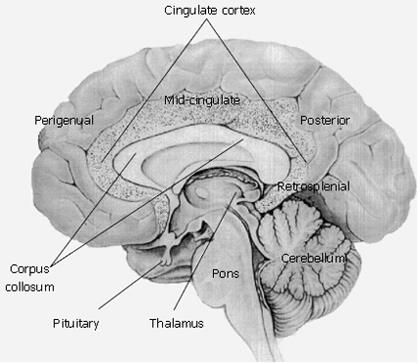Copyright
©2007 Baishideng Publishing Group Co.
World J Gastroenterol. Mar 7, 2007; 13(9): 1313-1332
Published online Mar 7, 2007. doi: 10.3748/wjg.v13.i9.1313
Published online Mar 7, 2007. doi: 10.3748/wjg.v13.i9.1313
Figure 6 Conscious perception of visceral sensations emerge from the cingulate region of the cerebral cortex.
Medial view of the brain showing organization of the cingulate cortex. Perigenual, midcingulate, posterior and retrosplenial are important structural and functional regions of the cingulate cortex with the following properties: (1) Perigenual anterior cingulate cortex surrounds the rostral portion of the cingulate cortex and is primarily involved in affect with a subsector devoted to visceromotor control via projections to the cranial parasympathetic and spinal sympathetic divisions of the autonomic nervous system. (2) Midcingulate cortex is involved in response selection and motivation and has a skeletomotor control subsector with neurons that project directly to the spinal cord. (3) Retrosplenial cingulate cortex is associated with memory recall. (4) Posterior cingulate cortex overlays the entire surface of the cingulate gyrus and has a caudomedial subsector that overlaps with the retrosplenial cingulate cortex. The retrosplenial cingulate cortex and posterior cingulate cortex are both involved in memory and activation of the caudomedial sector of the posterior cingulate cortex during memory of emotional events (e.g. emotional events associated with affect and gut function) provide an important framework for assessment of visceral function and disorder in brain imaging studies.
- Citation: Wood JD. Neuropathophysiology of functional gastrointestinal disorders. World J Gastroenterol 2007; 13(9): 1313-1332
- URL: https://www.wjgnet.com/1007-9327/full/v13/i9/1313.htm
- DOI: https://dx.doi.org/10.3748/wjg.v13.i9.1313









